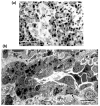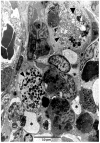Lympho-Hematopoietic Microenvironments and Fish Immune System
- PMID: 35625475
- PMCID: PMC9138301
- DOI: 10.3390/biology11050747
Lympho-Hematopoietic Microenvironments and Fish Immune System
Abstract
In the last 50 years information on the fish immune system has increased importantly, particularly that on species of marked commercial interest (i.e., salmonids, cods, catfish, sea breams), that occupy a key position in the vertebrate phylogenetical tree (i.e., Agnatha, Chondrichtyes, lungfish) or represent consolidated experimental models, such as zebrafish or medaka. However, most obtained information was based on genetic sequence analysis with little or no information on the cellular basis of the immune responses. Although jawed fish contain a thymus and lympho-hematopoietic organs equivalents to mammalian bone marrow, few studies have accounted for the presumptive relationships between the organization of these cell microenvironments and the known immune capabilities of the fish immune system. In the current review, we analyze this topic providing information on: (1) The origins of T and B lymphopoiesis in Agnatha and jawed fish; (2) the remarkable organization of the thymus of teleost fish; (3) the occurrence of numerous, apparently unrelated organs housing lympho-hematopoietic progenitors and, presumably, B lymphopoiesis; (4) the existence of fish immunological memory in the absence of germinal centers.
Keywords: MALT; T and B lymphocytes; germinal centers and immune memory; immunity; peripheral lymphoid organs; teleost fish; thymus.
Conflict of interest statement
The author declares no conflict of interest.
Figures




Similar articles
-
Ontogeny of the immune system of fish.Fish Shellfish Immunol. 2006 Feb;20(2):126-36. doi: 10.1016/j.fsi.2004.09.005. Fish Shellfish Immunol. 2006. PMID: 15939627 Review.
-
The relevance of cell microenvironments for the appearance of lympho-haemopoietic tissues in primitive vertebrates.Histol Histopathol. 1995 Jul;10(3):761-78. Histol Histopathol. 1995. PMID: 7579826 Review.
-
The influence of 17β-oestradiol on lymphopoiesis and immune system ontogenesis in juvenile sea bass, Dicentrarchus labrax.Dev Comp Immunol. 2021 May;118:104011. doi: 10.1016/j.dci.2021.104011. Epub 2021 Jan 16. Dev Comp Immunol. 2021. PMID: 33460678
-
Dietary Approaches to Attain Fish Health with Special Reference to their Immune System.Curr Pharm Des. 2018;24(41):4921-4931. doi: 10.2174/1381612825666190104121544. Curr Pharm Des. 2018. PMID: 30608037 Review.
-
Dendritic type, accessory cells within the mammalian thymic microenvironment. Antigen presentation in the dendritic neuro-endocrine-immune cellular network.In Vivo. 1997 Jul-Aug;11(4):351-70. In Vivo. 1997. PMID: 9292303
Cited by
-
Secreted novel AID/APOBEC-like deaminase 1 (SNAD1) - a new important player in fish immunology.Front Immunol. 2024 Mar 27;15:1340273. doi: 10.3389/fimmu.2024.1340273. eCollection 2024. Front Immunol. 2024. PMID: 38601149 Free PMC article. Review.
-
Fishing Innate Immune System Properties through the Transcriptomic Single-Cell Data of Teleostei.Biology (Basel). 2023 Dec 12;12(12):1516. doi: 10.3390/biology12121516. Biology (Basel). 2023. PMID: 38132342 Free PMC article. Review.
-
Morphological and Ultrastructural Insights into the Goldfish (Carassius auratus) Spleen: Immune Organization and Cellular Composition.Vet Sci. 2025 May 25;12(6):517. doi: 10.3390/vetsci12060517. Vet Sci. 2025. PMID: 40559754 Free PMC article.
-
Identification of a pharyngeal mucosal lymphoid organ in zebrafish and other teleosts: Tonsils in fish?Sci Adv. 2023 Nov 3;9(44):eadj0101. doi: 10.1126/sciadv.adj0101. Epub 2023 Nov 1. Sci Adv. 2023. PMID: 37910624 Free PMC article.
-
Ameliorative role of camel protein hydrolysates diet against alkaline stress in Oreochrmis niloticus: Hematology, immune responses and their regulating genes expression, and histopathological assays.Vet Res Commun. 2025 Jan 16;49(2):79. doi: 10.1007/s11259-024-10637-0. Vet Res Commun. 2025. PMID: 39821552
References
-
- Berthelot C., Brunet F., Chalopin D., Juanchich A., Bernard M., Noel B., Bento P., Da Silva C., Labadie K., Alberti A., et al. The rainbow trout genome provides novel insights into evolution after whole-genome duplication in vertebrates. Nat. Commun. 2014;5:3657. doi: 10.1038/ncomms4657. - DOI - PMC - PubMed
Publication types
Grants and funding
LinkOut - more resources
Full Text Sources

